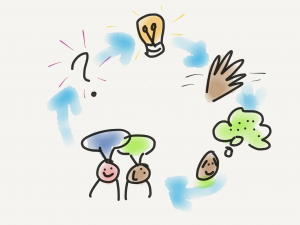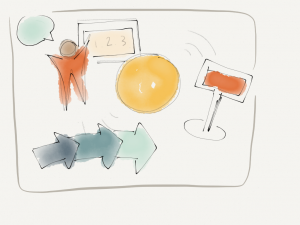 This is the last of four pieces reflecting on the experiences of Emilio, a subject matter expert who was tasked with converting his successful F2F training into an elearning offering. This one focuses on the lessons learned from the pilot and we are pulling in Cheryl Frankiewicz, the project manager. You can find the context in part 1 , part 2 and part 3. (Disclaimer: I was an adviser to the project and my condition of participation was the ability to do this series of blog posts, because there is really useful knowledge to share, both within the colleague’s organization and more widely. So I said I’d add the blog reflections – without pay – if I could share them.)
This is the last of four pieces reflecting on the experiences of Emilio, a subject matter expert who was tasked with converting his successful F2F training into an elearning offering. This one focuses on the lessons learned from the pilot and we are pulling in Cheryl Frankiewicz, the project manager. You can find the context in part 1 , part 2 and part 3. (Disclaimer: I was an adviser to the project and my condition of participation was the ability to do this series of blog posts, because there is really useful knowledge to share, both within the colleague’s organization and more widely. So I said I’d add the blog reflections – without pay – if I could share them.)
Nancy: Emilio and Cheryl, what is your advice for someone else embarking on this process?
Emilio: Solve the prep work for the launch. Pay a lot of attention to the very important thing you do in every single project, no matter what it is. Getting the process of getting the people there. The enrollment, selecting a good partner and being on top of your partner so that nothing goes wrong in this introduction process. The key thing is to get the people there at the start of your course. That has to go flawless. If it starts flawless, it is almost a piece of cake to do a good learning course. Then everything flows easily.
Cheryl: I would encourage others who embark on this process to start by revisiting their objectives and making sure that they measure the most important learning outcomes. Once the objectives are clear, focused and measurable, it’s much easier to make wise choices about which content and activities to include in the course design. Interaction is just as important in elearning as in F2F learning, but that doesn’t mean that all the interaction that takes place in the face-to-face environment should be transferred to the online environment. Attention spans are more limited and the demands on learners’ time are greater in an online environment, so you have to be careful not to include so much interaction that it becomes overwhelming to learners.
If you haven’t facilitated online before, take an elearning facilitation course before you deliver for the first time. I took one before I delivered my first online training and it was worth every penny I paid. Not only did I get useful tips on how to manage participation in a virtual environment, but I also had the opportunity to practice them before going “live”. The big surprise for me was how much I depended on participants’ body language for feedback in a F2F environment, and how lost I felt online without it. The course helped me identify other strategies for gathering and giving feedback online. Emilio wanted to take one of these courses but his travel schedule didn’t allow it.
One other recommendation I’d make is to plan for regular communication with learners. In a F2F setting, facilitators don’t have to think about how this will happen because they are in constant contact with learners, but in an elearning environment, extra effort has to be made to design and time communication in a way that helps keep participants on track and motivated to participate. Regular bulletins from the facilitator that remind participants what is happening in a given week or unit are a valuable tool for accomplishing this. These bulletins can also highlight key lessons learned or insightful contributions from participants during the previous week. The review can help re-engage those that have fallen behind, and the recognition can help motivate quality participation in the future.
Nancy: Emilio, I have done quite a bit of work with your organization around learning, facilitating and elearning. As you think about your experiences and the experiences you’ve learned from other colleagues doing elearning in FAO, what capacity is needed to do this sort of work in an organization like yours?
Emilio: We have our own elearning team at FAO doing their own projects for specific groups. Their services are relatively expensive. If I were to do with them the same thing I did with MEDA I would have likely paid more. And they have a limited number of people. They don’t have enough capacity to be service providers to the rest of the organization. We have so many different units. Our organization is structured so that we have to provide services to each other and we have to pay for them.
Nancy: I know there is a lot of talent spread through the organization, but it is not clear that they are aware of each other, talk to each other, learn and support each other.
Emilio: You are right. I have a colleague doing a training. She decided to work with Unitar. She is thrilled with the experience. Then she started talking about her very different needs and experiences. From what she tells me I would not be inclined to use that model. I would have to have something different. It is hard at the end of the day to come up with a corporate, very well coordinated approach to this elearning, to cultivate that knowledge among all of FAO’s staff, or at least expand it as much as possible.
But you are right, the result is we don’t leverage, learn from each other, from a very valuable experience a colleague is having and have to go through painful process of learning myself.
Cheryl, how about you? What is your advice?
Cheryl: Don’t aim for the moon in your beta test. Aim to learn. As Emilio mentioned, only 41% of those who registered for the course actually completed it. But 100% of those who completed it said they would recommend it to their colleagues. Learning happened, and more learning will happen the next time around because Emilio and his team are observant, open to learning, and patient with themselves and the process.
Make sure you bring together a good team of people who can cover all the bases that need to be covered when converting a F2F training into an elearning offering. Don’t expect that any one person is going to be your subject matter expert, instructional designer, programmer, learning strategist, platform troubleshooter and project manager all in one. Ultimately, a team of six people contributed to this conversion, none of us working on it full time, but all of us contributing expertise in a particular area. Make sure that someone on the team takes responsibility for organizing the work and keeping your timeline on track. And avoid the temptation to outsource everything because you’ll miss the opportunity to learn how to do it yourself. Emilio’s probably not ready to develop his next course entirely in-house, but he and Milica have built the capacity to maintain and adapt the courses that now exist.
Speaking of adaptation, one last piece of advice is to take advantage of the opportunities that elearning provides to monitor how participants are learning as they are learning and make adjustments to the course design as you go along. Emilio mentioned earlier that the feedback he received in the office hours helped him adjust the course materials, but our analysis of the quiz, final exam and evaluation results also helped us identify which concepts could be better explained, and which objectives could be better supported. We monitored how, when and where learners engaged (and did not engage) and this is helping Emilio to improve his next offering of the course. For example, we learned that participants who did not complete the course tended to follow one of two patterns: approximately one-third logged in only once or twice and did not finish even the first module; the other two-thirds participated fairly regularly and completed module 2, but then dropped out. With this information, and with feedback from participants who completed the course, Emilio is revising the design of the Module 2 group work, and he and Milica are planning to follow up more quickly with inactive participants during the first module of the course to identify if there are any barriers to participation that they might help learners address.
Here’s mine (Nancy)…
I’m really glad the decision was made to have a beta test which helps us sharpen the content, process, assessment and technology. The example of understanding how the exam was graded shows that there are always technical things to learn, and the careful attention to assessment as it relates to learning objectives helped us learn a lot.
We learned some things about the process of having a marketing partner, the importance of lead time and a very real need to do some pre-course orientation for the learners about the technology and course expectations. We have talked about developing some short videos and having a short “week 0” prior to the actual start of the course to ensure the tech is working for learners before we dive so quickly into content and community building.
We need to get the participation rate higher because I’m convinced that is key to successful completion – look at the people who participated in the office hours — they stayed engaged and completed! I think this starts with a clearer ramp up and explicit expectations (including pre-course communications), regular emails during the course and refinement of our pre-course learner survey that would help the facilitator understand the learners a bit before the course.
That said, there were SO many things to pay attention to, it was easy to spend less time on the social aspects of learning: initial engagement with the learners, building a learning community (which is difficult in three weeks and limited expectation of learner hours), and helping learners contextualize the content to their contexts. I had warned Emilio beforehand that facilitating online learning is a bit different than teaching face to face. The learning management system delivers a lot of the content. The real role is connecting learners to the content and to each other.
Thanks to Emilio, Cheryl, FAO and MEDA for supporting these four blog reflections!


 Social Media Strategy Planning & Measurement – What’s Working?
Social Media Strategy Planning & Measurement – What’s Working?